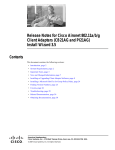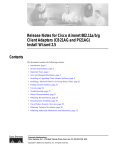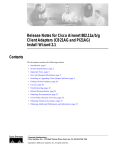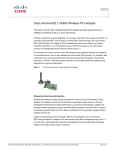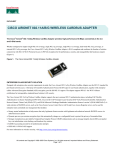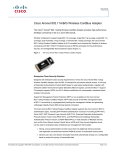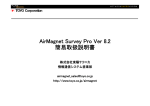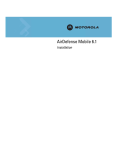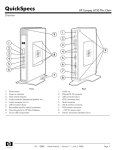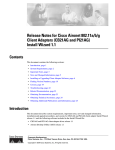Download Cisco AIRONET CB21AG Technical information
Transcript
Release Notes for Cisco Aironet 802.11a/b/g
Client Adapters (CB21AG and PI21AG)
Install Wizard 3.0
Contents
This document contains the following sections:
•
Introduction, page 2
•
System Requirements, page 2
•
Important Notes, page 3
•
New and Changed Information, page 6
•
Installing or Upgrading Client Adapter Software, page 7
•
Installing a Microsoft Hot Fix for Group Policy Delay, page 23
•
Finding Version Numbers, page 24
•
Caveats, page 25
•
Troubleshooting, page 28
•
Related Documentation, page 29
•
Obtaining Documentation, page 29
•
Documentation Feedback, page 30
•
Cisco Product Security Overview, page 30
•
Obtaining Technical Assistance, page 31
•
Obtaining Additional Publications and Information, page 33
Corporate Headquarters:
Cisco Systems, Inc., 170 West Tasman Drive, San Jose, CA 95134-1706 USA
Copyright © 2006 Cisco Systems, Inc. All rights reserved.
Introduction
Introduction
This document describes system requirements, important notes, new and changed information,
installation and upgrade procedures, and caveats for CB21AG and PI21AG client adapter Install Wizard
release 3.0 and the following software included in the Install Wizard file:
•
CB21AG and PI21AG client adapter driver release 3.0
•
Aironet Desktop Utility (ADU) release 3.0
•
Cisco Aironet Site Survey Utility release 1.3.01
System Requirements
You need the following items in order to install Install Wizard 3.0 and use its software components:
•
One of the following Cisco Aironet client adapters:
– CB21AG PC-Cardbus card
– PI21AG PCI card
•
A computer running the Windows 2000 or XP operating system
Note
Cisco recommends a 300-MHz (or greater) processor.
•
Service Pack 2 for Windows XP
•
20 MB of free hard disk space (minimum)
•
128 MB of RAM or greater (recommended)
•
If your wireless network uses EAP-TLS or PEAP authentication, Certificate Authority (CA) and
user certificates for EAP-TLS authentication or CA certificate for PEAP authentication
•
If your wireless network uses PEAP (EAP-GTC) authentication with a One-Time Password (OTP)
user database:
– A hardware token device from OTP vendors or the Secure Computing SofToken program
(version 2.1 or later)
– Your hardware or software token password
•
The Microsoft 802.1X supplicant, if your client adapter is installed on a Windows 2000 device and
uses PEAP (EAP-MSCHAPV2) with machine authentication
•
All necessary infrastructure devices (such as access points, servers, gateways, user databases, etc.)
must be properly configured for any authentication type you plan to enable on the client.
•
The following information from your system administrator:
– The logical name for your workstation (also referred to as client name)
– The protocols necessary to bind to the client adapter, such as TCP/IP
– The case-sensitive service set identifier (SSID) for your RF network
– If your network setup does not include a DHCP server, the IP address, subnet mask, and default
gateway address of your computer
Release Notes for Cisco Aironet 802.11a/b/g Client Adapters (CB21AG and PI21AG) Install Wizard 3.0
2
OL-8338-01
Important Notes
– The wired equivalent privacy (WEP) keys of the access points with which your client adapter
will communicate, if your wireless network uses static WEP for security
– The username and password for your network account
– Protected access credentials (PAC) file if your wireless network uses EAP-FAST authentication
with manual PAC provisioning
Important Notes
Mismatch between HP DC5 100 PCI Bus Controller and PCI Key Cache Register
on PI21AG Chip
A mismatch exists between the HP DC5100 PCI bus controller and the PCI key cache register on the
chip of the PI21AG. The key cache uses a 48-bit register in which the PI21AG sends out two writes on
the PCI bus back to back (DWORD and WORD). The controller on the device cannot handle two
consecutive write cycles on the bus, which causes a fatal error on the PCI bus.
You should slow down the write operations to the key cache by performing a register read before and
after a register write. To slow down the write operations, install registry key "singleWriteKC=1." The
path of the "singleWriteKC=1" registry key is the following:
HKEY_LOCAL_MACHINE\SYSTEM\CurrentControlSet\Control\Class\{4D36E972-E325-11CE-BF
C1-08002bE10318}
You should not see any system degradation or performance hits, as the key cache is only changed every
few minutes. An additional read before the second write cycle only lasts a few micro seconds in the PCI
space.
Installing the CB21AG Intermediate Driver Manually
In some instances, the installation of the CB21AG software might not work as expected because the
intermediate driver might not have installed correctly. In this situation, the installer might not detect
this condition, and the rest of the software will not function correctly.
The CB21AG intermediate driver must be installed manually. To install the intermediate driver
manually, follow these steps:
Step 1
Insert the client adapter.
Step 2
Click on "Network Connections" in the Start > Settings menu in Windows XP, or right click on "My
Network Places" in Windows 2000. Find the CB21AGg instance.
Step 3
Right click on the Cisco CB21AG instance, and left click on Properties.
Step 4
Choose the "Install" option and then add a new service.
Step 5
Choose the "Have disk" button. Go to \windows\system32 directory and choose wsimd.inf.
Step 6
Highlight and select "Wireless Intermediate Driver" and click "ok" button. The wireless IMD is bound
to the adapter.
Step 7
Reboot system.
Release Notes for Cisco Aironet 802.11a/b/g Client Adapters (CB21AG and PI21AG) Install Wizard 3.0
OL-8338-01
3
Important Notes
Incompatibility between PACs Created by ACS Version 3.x.xx and
ACS Version 4.0.xx
PACs that are created by ACS version 3.x.xx are not compatible with ACS version 4.0.xx. Client stations
must import new PACs. If you select auto-provisioning, new PACs will automatically be generated and
used. However, if you select manual provisioning, you must manually export new PACs to the client
stations.
If a user wants to authenticate to ACS version 4.0.xx and version 3.x.xx at different times, both PACs
must remain on the client station. The ADU is capable of automatically selecting the appropriate PAC.
However, if you experiences authentication failures after upgrading the software, delete all the PACs
provisioned from the 3.x.xx server.
Conflict with Third-Party Supplicants
When using release 3.0, you might encounter a conflict with third-party supplicants (such as the
Meetinghouse Aegis or the Juniper Odyssey) that causes the Cisco client adapter to lose connection. If
you encounter such a conflict, disable third-party supplicants.
Customized Installation Images (Notice to IT Professionals)
Caution
Use caution when bundling the client adapter software into a customized installation image. If the
registry settings are modified, the software may not install and uninstall properly.
Client Adapter Software Compatibility
Caution
Cisco Aironet CB21AG and PI21AG client adapter software is incompatible with other Cisco Aironet
client adapter software. The Aironet Desktop Utility (ADU) must be used with CB21AG and PI21AG
cards, and the Aironet Client Utility (ACU) must be used with all other Cisco Aironet client adapters.
Installing the Novell Client
If you are going to use the Novell Client, be sure to install it on your computer prior to installing the
client adapter software.
Enabling CCKM Fast Secure Roaming
If you want to enable CCKM on the client adapter, you must choose the WPA/WPA2/CCKM security
option, regardless of whether you want the adapter to use WPA or WPA2. The configuration of the access
point to which your client adapter associates determines whether CCKM will be used with 802.1x, WPA,
or WPA2.
Release Notes for Cisco Aironet 802.11a/b/g Client Adapters (CB21AG and PI21AG) Install Wizard 3.0
4
OL-8338-01
Important Notes
Access Point Setting for LEAP or EAP-FAST Authentication
Access points must be set for both Network-EAP and open authentication in order to associate to
CB21AG and PI21AG client adapters running LEAP with WPA/WPA2/CCKM or EAP-FAST.
EAP-FAST Fails When Access Point Configured as Local RADIUS Server
The client adapter fails to authenticate using EAP-FAST when the access point is running Cisco IOS
Release 12.3(2)JA2 and is configured as a local RADIUS server. The following message appears:
“Unable to EAP-FAST authenticate the wireless user in the specified amount of time. Network
infrastructure might be down.”
GINA Error on Bootup
If your computer ever experiences a GINA error on bootup, boot to the safe mode command prompt.
Then copy the msgina.dll file in the WinNT\System32 directory (Windows 2000) or Windows\System32
directory (Windows XP) over to a file named cscogina.dll. The copy command enables you to copy a
source file (msgina.dll) to a destination file (cscogina.dll) within the same directory.
Reboot Required When Uninstalling ACU and ADU
Caution
When you uninstall ACU and ADU, be sure to reboot your computer when prompted. Otherwise, the
system may be rendered unable to boot, displaying the message “The Logon User Interface DLL
cswGina.dll failed to load. Contact your system administrator to replace the DLL or restore the original
DLL.”
Uninstalling Software Components
All profiles and stored PAC files are deleted if you use the Uninstall the previous installation option
on the Previous Installation Detected Install Wizard window to uninstall the client adapter software.
Cisco recommends that you use the Profile Manager’s export feature to save your profiles before
uninstalling the software.
Profiles for PC-Cardbus Cards
The profiles for PC-Cardbus cards are tied to the slot in which the card is inserted. Therefore, you must
always insert your PC-Cardbus card into the same slot, create profiles for both slots, or export the
profiles for one slot and import them for the other slot.
Release Notes for Cisco Aironet 802.11a/b/g Client Adapters (CB21AG and PI21AG) Install Wizard 3.0
OL-8338-01
5
New and Changed Information
Auto Profile Selection Enables Scan of Wireless Modes in Auto-Selected
Profiles
When you enable auto profile selection, the client adapter ignores the selected profile’s wireless mode
setting and scans the wireless modes specified by all the profiles in the auto profile selection list for an
available network. Using this method, the client does not need to disassociate nor change the current
profile while looking for networks in other profiles.
ASTU Exit Option
The Exit option on the Aironet System Tray Utility (ASTU) pop-up menu closes both ASTU and ADU.
Windows Wireless Network Connection Icon Shows Unavailable Connection
(Windows XP Only)
If your computer is running Windows XP and you configured your client adapter using ADU, the
Windows Wireless Network Connection icon in the Windows system tray may be marked with a red X
and show an unavailable connection even though a wireless connection exists. This condition is caused
by a conflict between ADU and Windows XP’s wireless network settings. Simply ignore the Windows
icon and use the ASTU icon to check the status of your client adapter’s wireless connection.
Supporting Documentation
The Cisco Aironet 802.11a/b/g Wireless LAN Client Adapters (CB21AG and PI21AG) Installation and
Configuration Guide (OL-4211-05) pertains specifically to CB21AG and PI21AG client adapters. If you
are using a Cisco Aironet 340, 350, or CB20A client adapter, refer to the Installation and Configuration
Guide for that client adapter and your computer’s operating system.
New and Changed Information
EAP-FAST Enhancements
The following is a list of EAP-FAST enhancements, which are accessible through the ADU user
interface:
•
Support of additional EAP authentication methods
Version 3.0 of ADU supports three EAP methods in both the PAC auto provisioning phase and the
EAP-FAST authentication phase. These methods are:
– EAP-MSCHAPv2
– EAP-GTC
– EAP-TLS
•
PAC configuration and management screens
Release Notes for Cisco Aironet 802.11a/b/g Client Adapters (CB21AG and PI21AG) Install Wizard 3.0
6
OL-8338-01
Installing or Upgrading Client Adapter Software
Version 3.0 of ADU has updated PAC configuration screens.
•
Minor updates to other screens
For more information about the new updates, refer to chapters 6 and 5 of the Cisco Aironet 802.11a/b/g
Wireless LAN Client Adapters (CB21AG and PI21AG) Installation and Configuration Guide,
OL-4211-05.
PAC Export
In the previous version, when an EAP-FAST profile is exported or imported, the PAC data linked with
the profile was getting ignored. To solve this problem, version 3.0 of ADU supports the exporting of PAC
data using .PAC files.
Installing or Upgrading Client Adapter Software
This section describes how to initially install or upgrade to CB21AG and PI21AG Install Wizard 3.0 on
a computer running Windows 2000 or XP. If the client adapter software is not installed on your computer,
follow the instructions in the “Installing or Upgrading Client Adapter Software” section below. If you
are upgrading your client adapter software to release 3.0, follow the instructions in the “Upgrading the
Client Adapter Software” section on page 19.
Installing the Client Adapter Software
This section describes how to install Cisco Aironet CB21AG or PI21AG client adapter driver and
utilities from a single executable file named WinClient-802.11a-b-g-Ins-Wizard-vx.exe, where x
represents the release number. Follow these steps to install these client adapter software components on
a computer running Windows 2000 or XP.
Caution
Cisco Aironet CB21AG and PI21AG client adapter software is incompatible with other Cisco Aironet
client adapter software. The Aironet Desktop Utility (ADU) must be used with CB21AG and PI21AG
cards, and the Aironet Client Utility (ACU) must be used with all other Cisco Aironet client adapters.
Caution
Do not eject your client adapter at any time during the installation process, including during the reboot.
Note
This procedure is meant to be used the first time the Cisco Aironet CB21AG or PI21AG client adapter
software is installed on your computer. If this software is already installed on your computer, follow the
instructions in Chapter 9 to upgrade the client adapter software.
Note
Only one CB21AG or PI21AG client adapter can be installed and used at a time. The software does not
support the use of multiple CB21AG or PI21AG cards.
Release Notes for Cisco Aironet 802.11a/b/g Client Adapters (CB21AG and PI21AG) Install Wizard 3.0
OL-8338-01
7
Installing the Client Adapter Software
Step 1
Make sure the client adapter is inserted into your computer.
Step 2
Make sure that you have a Cisco Connection Online (CCO) username and password.
Step 3
If you do not have a CCO username and password, go to Cisco’s main page (http://www.cisco.com) and
click Register (top). Then, follow the instructions to create a CCO username and password.
Step 4
Browse to the following location:
http://www.cisco.com/public/sw-center/
Step 5
Click Wireless Software.
Step 6
Click Wireless LAN Access.
Step 7
Click Cisco Wireless LAN Client Adapters.
Step 8
Click Cisco Aironet Wireless LAN Client Adapters.
Step 9
Perform one of the following steps:
•
If you are using a PC-Cardbus card, click Cisco Aironet 802.11a/b/g CardBus Wireless LAN
Client Adapter (CB21AG).
•
If you are using a PCI card, click Cisco Aironet 802.11a/b/g PCI Wireless LAN Client Adapter
(PI21AG).
Step 10
When prompted, enter your CCO username and password, and click OK.
Step 11
Click Aironet Client Installation Wizard (Firmware, Driver, Utility).
Step 12
Click Windows 2000 or Windows XP.
Step 13
Click the link with the greatest release number.
Step 14
Click the Install Wizard file (WinClient-802.11a-b-g-Ins-Wizard-vxx.exe), where xx is the version
number.
Step 15
If prompted, enter your CCO username and password, and click OK.
Step 16
Complete the encryption authorization form, read and accept the terms and conditions of the Software
License Agreement, select the file again to download it, and save the file on your computer’s Desktop.
Step 17
Use Windows Explorer to find the installer.
Step 18
Double-click the installer. The “Starting InstallShield Wizard” message appears followed by the
Preparing Setup window (see Figure 1) and the Cisco Aironet Installation Program window (see
Figure 2).
Release Notes for Cisco Aironet 802.11a/b/g Client Adapters (CB21AG and PI21AG) Install Wizard 3.0
8
OL-8338-01
Installing the Client Adapter Software
Figure 1
Preparing Setup Window
Release Notes for Cisco Aironet 802.11a/b/g Client Adapters (CB21AG and PI21AG) Install Wizard 3.0
OL-8338-01
9
Installing the Client Adapter Software
Figure 2
Step 19
Cisco Aironet Installation Program Window
Click Next. The Setup Type window appears (see Figure 3).
Release Notes for Cisco Aironet 802.11a/b/g Client Adapters (CB21AG and PI21AG) Install Wizard 3.0
10
OL-8338-01
Installing the Client Adapter Software
Figure 3
Step 20
Setup Type Window
Choose one of the following options and click Next:
Note
To ensure compatibility among software components, Cisco recommends that you install the
client utilities and driver.
•
Install Client Utilities and Driver—Installs the client adapter driver and client utilities.
•
Install Driver Only—Installs only the client adapter driver. If you choose this option, click Next
and go to Step 32.
•
Make Driver Installation Diskette(s)—Enables you to create driver installation diskettes that can
be used to install drivers using the Windows Device Manager.
Note
If you choose one of the first two options and a client adapter is not inserted into your computer,
the following message appears: “The device may not be present or could have been
ejected/unplugged from the system. Insert or reinsert it now.” Insert the client adapter and click
OK. If you proceed without the client adapter inserted, the installation continues, but the driver
installation is incomplete. You must manually install the driver later using the Update Device
Driver Wizard. See Chapter 9 of the Cisco Aironet 802.11a/b/g Wireless LAN Client Adapters
(CB21AG and PI21AG) Installation and Configuration Guide for instructions.
Release Notes for Cisco Aironet 802.11a/b/g Client Adapters (CB21AG and PI21AG) Install Wizard 3.0
OL-8338-01
11
Installing the Client Adapter Software
Step 21
When the Install Cisco Aironet Site Survey Utility window appears (see Figure 4), check the Install
Cisco Aironet Site Survey Utility check box if you want to install a utility that helps you to determine
the best placement of infrastructure devices within your wireless network. Click Next.
Figure 4
Note
Step 22
Install Cisco Aironet Site Survey Utility Window
See Appendix F of the Cisco Aironet 802.11a/b/g Wireless LAN Client Adapters (CB21AG and
PI21AG) Installation and Configuration Guide for instructions on using the utility.
If a message appears indicating that you are required to restart your computer at the end of the
installation process, click Yes.
Note
If you click No, you are asked to confirm your decision. If you proceed, the installation process
terminates.
The Choose Destination Location window appears (see Figure 5).
Release Notes for Cisco Aironet 802.11a/b/g Client Adapters (CB21AG and PI21AG) Install Wizard 3.0
12
OL-8338-01
Installing the Client Adapter Software
Figure 5
Step 23
Perform one of the following:
•
If you chose the first option in Step 20, click Next to install the client utility files in the C:\Program
Files\Cisco Aironet directory.
Note
•
If you want to install the client utilities in a different directory, click Browse, choose a
different directory, click OK, and click Next.
If you chose the Make Driver Installation Diskette(s) option in Step 20, insert a floppy disk into your
computer and click Next to copy the driver to the diskette. Go to Step 32.
Note
Step 24
Choose Destination Location Window
If you want to copy the driver to a different drive or directory, click Browse, choose a new
location, click OK, and click Next.
The Select Program Folder window appears (see Figure 6).
Release Notes for Cisco Aironet 802.11a/b/g Client Adapters (CB21AG and PI21AG) Install Wizard 3.0
OL-8338-01
13
Installing the Client Adapter Software
Figure 6
Step 25
Click Next to add program icons to the Cisco Aironet program folder.
Note
Step 26
Select Program Folder Window
If you want to specify a different program folder, choose a folder from the Existing Folders list
or type a new folder name in the Program Folder field and click Next.
If your computer is running Windows 2000, go to Step 32. If your computer is running Windows XP, the
window titled IMPORTANT: Please Read! appears (see Figure 7).
Release Notes for Cisco Aironet 802.11a/b/g Client Adapters (CB21AG and PI21AG) Install Wizard 3.0
14
OL-8338-01
Installing the Client Adapter Software
Figure 7
Step 27
IMPORTANT: Please Read! Window
Read the information displayed and click Next. The Choose Configuration Tool window appears (see
Figure 8).
Release Notes for Cisco Aironet 802.11a/b/g Client Adapters (CB21AG and PI21AG) Install Wizard 3.0
OL-8338-01
15
Installing the Client Adapter Software
Figure 8
Step 28
Choose Configuration Tool Window
Choose one of the following options:
•
Cisco Aironet Desktop Utility (ADU)—Enables you to configure your client adapter using ADU.
•
Third-Party Tool—Enables you to configure your client adapter using a third-party tool such as the
Microsoft Wireless Configuration Manager in Windows XP.
Table 1 compares Windows XP and ADU client adapter features.
Table 1
Comparison of Windows XP and ADU Client Adapter Features
Feature
Windows XP
ADU
Limited
Extensive
Create profiles
Yes
Yes
Enable/disable radio
No
Yes
Configuration parameters
Capabilities
Release Notes for Cisco Aironet 802.11a/b/g Client Adapters (CB21AG and PI21AG) Install Wizard 3.0
16
OL-8338-01
Installing the Client Adapter Software
Table 1
Comparison of Windows XP and ADU Client Adapter Features
Feature
Windows XP
ADU
Static WEP
Yes
Yes
LEAP or EAP-FAST authentication
with dynamic WEP
No
Yes
EAP-TLS or PEAP authentication
Yes
Yes
Limited
Extensive
No
Yes
Security
Status and statistics
Status window
Statistics window (transmit &
receive)
Note
If you choose Cisco Aironet Desktop Utility (ADU) above, the Microsoft Wireless
Configuration Manager is disabled. If you ever manually enable it, you are prompted to disable
it whenever ADU is activated.
Step 29
Click Next.
Step 30
If you chose Cisco Aironet Desktop Utility (ADU) in Step 28, go to Step 32. If you chose Third-Party
Tool, the Enable Tray Icon window appears (see Figure 9).
Figure 9
Enable Tray Icon Window
Release Notes for Cisco Aironet 802.11a/b/g Client Adapters (CB21AG and PI21AG) Install Wizard 3.0
OL-8338-01
17
Installing the Client Adapter Software
Step 31
Check the Enable Cisco Aironet System Tray Utility (ASTU) check box if you want to be able to use
ASTU even though you have chosen to configure your client adapter through a third-party tool instead
of ADU and click Next.
Step 32
When prompted to insert your client adapter, click OK. The Setup Status window appears (see
Figure 10).
Figure 10
Setup Status Window
The installation process begins, and you are notified as each software component is installed.
Step 33
When a message appears indicating that your computer needs to be rebooted, click OK and allow your
computer to restart.
Step 34
If the Windows Found New Hardware Wizard appears after your computer reboots, click Next, allow the
wizard to install the software for the client adapter, and click Finish.
Step 35
If your network setup does not include a DHCP server and you plan to use TCP/IP, follow these steps
for your operating system.
•
Windows 2000
a. Double-click My Computer, Control Panel, and Network and Dial-up Connections.
b. Right-click Local Area Connection x (where x represents the number of the connection).
c. Click Properties.
d. In the Components Checked Are Used by This Connection field, click Internet Protocol
(TCP/IP) and Properties.
Release Notes for Cisco Aironet 802.11a/b/g Client Adapters (CB21AG and PI21AG) Install Wizard 3.0
18
OL-8338-01
Installing the Client Adapter Software
e. Choose Use the following IP address and enter the IP address, subnet mask, and default gateway
address of your computer (which can be obtained from your system administrator).
f.
•
Click OK to close each open window.
Windows XP
a. Double-click My Computer, Control Panel, and Network Connections.
b. Right-click Wireless Network Connection x (where x represents the number of the connection).
c. Click Properties.
d. In the This Connection Uses the Following Items field, click Internet Protocol (TCP/IP) and
Properties.
e. Choose Use the following IP address and enter the IP address, subnet mask, and default gateway
address of your computer (which can be obtained from your system administrator).
f.
Click OK to close each open window.
Step 36
If you are prompted to restart your computer, click Yes.
Step 37
Now that your client adapter is properly installed, it is ready to be configured.
•
If you are planning to configure your client adapter through ADU, go to Chapter 4 of the Cisco
Aironet 802.11a/b/g Wireless LAN Client Adapters (CB21AG and PI21AG) Installation and
Configuration Guide for more information.
•
If you are planning to configure your client adapter through the Windows XP Wireless Configuration
Manager, go to Appendix E of the Cisco Aironet 802.11a/b/g Wireless LAN Client Adapters
(CB21AG and PI21AG) Installation and Configuration Guide for more information.
•
If you are planning to configure your client adapter through another third-party tool, refer to the
documentation for that application.
Note
If you want to be able to use ADU’s Group Policy Delay parameter, follow the instructions below to
download and install a necessary hot fix before configuring your client adapter.
Note
If you experienced problems during or after installation, refer to Chapter 10 of the Cisco Aironet
802.11a/b/g Wireless LAN Client Adapters (CB21AG and PI21AG) Installation and Configuration Guide
for more information for troubleshooting information.
Upgrading the Client Adapter Software
Follow these steps to upgrade your CB21AG or PI21AG client adapter software to release 3.0 using the
settings that were selected during the last installation.
Note
If you want to upgrade your client adapter software using new installation settings, you must uninstall
the previous installation [see the instructions in Chapter 9 of the Cisco Aironet 802.11a/b/g Wireless LAN
Client Adapters (CB21AG and PI21AG) Installation and Configuration Guide] and then follow the
instructions in the “Installing the Client Adapter Software” section on page 7 to install the new software.
Release Notes for Cisco Aironet 802.11a/b/g Client Adapters (CB21AG and PI21AG) Install Wizard 3.0
OL-8338-01
19
Installing the Client Adapter Software
Step 1
Make sure the client adapter is inserted into your computer.
Step 2
Make sure that you have a Cisco Connection Online (CCO) username and password.
Step 3
If you do not have a CCO username and password, go to Cisco’s main page (http://www.cisco.com) and
click Register (top). Then, follow the instructions to create a CCO username and password.
Step 4
Browse to the following location:
http://www.cisco.com/public/sw-center/
Step 5
Click Wireless Software.
Step 6
Click Wireless LAN Access.
Step 7
Click Cisco Wireless LAN Client Adapters.
Step 8
Click Cisco Aironet Wireless LAN Client Adapters.
Step 9
Perform one of the following steps:
•
If you are using a PC-Cardbus card, click Cisco Aironet 802.11a/b/g CardBus Wireless LAN
Client Adapter (CB21AG).
•
If you are using a PCI card, click Cisco Aironet 802.11a/b/g PCI Wireless LAN Client Adapter
(PI21AG).
Step 10
When prompted, enter your CCO username and password, and click OK.
Step 11
Click Aironet Client Installation Wizard (Firmware, Driver, Utility).
Step 12
Click Windows 2000 or Windows XP.
Step 13
Click the link with the greatest release number.
Step 14
Click the Install Wizard file (WinClient-802.11a-b-g-Ins-Wizard-vxx.exe), where xx is the version
number.
Step 15
If prompted, enter your CCO username and password, and click OK.
Step 16
Complete the encryption authorization form, read and accept the terms and conditions of the Software
License Agreement, select the file again to download it, and save the file on your computer’s Desktop.
Step 17
Use Windows Explorer to find the installer.
Step 18
Double-click the installer. The “Starting InstallShield Wizard” message appears followed by the
Preparing Setup window (see Figure 11) and the Cisco Aironet Installation Program window (see
Figure 12).
Release Notes for Cisco Aironet 802.11a/b/g Client Adapters (CB21AG and PI21AG) Install Wizard 3.0
20
OL-8338-01
Installing the Client Adapter Software
Figure 11
Preparing Setup Window
Release Notes for Cisco Aironet 802.11a/b/g Client Adapters (CB21AG and PI21AG) Install Wizard 3.0
OL-8338-01
21
Installing the Client Adapter Software
Figure 12
Previous Installation Detected Window
Step 19
Choose Update the previous installation and click Next.
Step 20
When a message appears indicating that you are required to restart your computer at the end of the
installation process, click Yes.
Note
If you click No, you are asked to confirm your decision. If you proceed, the installation process
terminates.
The Setup Status window appears (see Figure 13).
Release Notes for Cisco Aironet 802.11a/b/g Client Adapters (CB21AG and PI21AG) Install Wizard 3.0
22
OL-8338-01
Installing a Microsoft Hot Fix for Group Policy Delay
Figure 13
Setup Status Window
The upgrade process begins, and you are notified as each software component is installed.
Step 21
When a message appears indicating that your computer needs to be rebooted, click OK and allow your
computer to restart. The client adapter’s software has been upgraded.
Installing a Microsoft Hot Fix for Group Policy Delay
If you want to use the Group Policy Delay parameter on the Profile Management (Security) window in
ADU, you must install a Microsoft hot fix on computers running Windows 2000. The hot fix is
incorporated into Windows XP Service Pack 2 and later.
The Group Policy Delay parameter enables you to specify how much time elapses before the Windows
logon process starts Group Policy, a Windows feature used by administrators to specify configuration
options for groups of users. The objective is to delay the start of Group Policy until wireless network
authentication occurs. Follow the steps below to obtain and install the hot fix.
Note
You must be a registered Cisco customer and log into Cisco.com in order to download the hot fix. If you
are unable to access the hot fix from Cisco.com, contact Microsoft Support to obtain it. The Windows
2000 support page provides the contact information:
http://support.microsoft.com/default.aspx?scid=fh;EN-US;win2000
Release Notes for Cisco Aironet 802.11a/b/g Client Adapters (CB21AG and PI21AG) Install Wizard 3.0
OL-8338-01
23
Finding Version Numbers
Step 1
Use your computer’s web browser to access the following URL:
http://www.cisco.com/cgi-bin/tablebuild.pl/aironet_hotfix
Step 2
If prompted, enter your Cisco Connection Online (CCO) username and password, and click OK.
Note
To create a CCO username and password, visit http://www.cisco.com.
Step 3
Click the hot fix file (userenv.zip).
Step 4
Complete the encryption authorization form and click Submit.
Step 5
Click the file again to download it.
Step 6
Save the file to your computer’s hard drive.
Step 7
Find the file using Windows Explorer, double-click it, and extract its files to a folder.
Step 8
Reboot your computer and press F8 while your computer is booting.
Step 9
When the boot menu appears, select Safe Mode with Command Prompt.
Note
You must complete this procedure in safe mode; otherwise, system file protection (SFP) will
silently restore the original version of the file you are replacing.
Step 10
Copy the hot fix file (userenv.dll) to %systemroot%\System32 and overwrite the existing version of this
file.
Step 11
Delete the copy of userenv.dll in %systemroot%\System32\DllCache.
Step 12
Restart your computer.
Finding Version Numbers
Follow the instructions in this section to find the version numbers of your client adapter’s software
components.
Finding the Driver Version
To find the driver version that is currently installed for your client adapter, open ADU, click the
Diagnostics tab, and click Adapter Information. The Driver Version field on the Adapter Information
window shows the current driver version.
Finding the Version of ADU and Other Software Components
To find the version of ADU and other software components installed for your client adapter, open ADU
and choose the About Aironet Desktop Utility option from the Help drop-down menu. The About
window shows the current version of the following software components: ADU, ACAU, the
authentication supplicant, the protocol driver, and the Windows NDIS miniport driver.
Release Notes for Cisco Aironet 802.11a/b/g Client Adapters (CB21AG and PI21AG) Install Wizard 3.0
24
OL-8338-01
Caveats
Caveats
This section describes the open, resolved, and closed caveats for the software components in this release.
Open Caveats
The following caveats are not resolved in CB21AG and PI21AG client adapter software release 3.0:
•
CSCsd31365—When the client connects to an access point that does not broadcast its SSID, the
Cisco Aironet Site Survey Utility AP Scan List may not the access point’s SSID for a short time.
•
CSCsd80390—The “No machine certificates were found on your computer” message is misleading
When using the Cisco AIR-CB21AG-A-K9 802.11/a/b/g client adapters and running ADU 2.6.0.1,
if you try to select ADU clients using EAP-TLS authentication, you see a message stating that no
machine certificates were found on your computer, even though the application automatically finds
the machine certificates. Also, if you select Use machine Information for Domain Logon under
EAP-TLS configuration, you get the same error message. This message will not cause any problem
and should only be seen once.
•
CSCsd86612—If a user enters an incorrect password, the ADU will prompt the user to re-enter the
password, but the ACS server will not record an invalid login attempt in its logs.
This behavior is by design. The ACS server does not log an EAP failure because it gives the user a
chance to reauthenticate.
•
CSCse05471—The CB21 client adapter cannot pass the authentication phase with a Traditional
Chinese username
This only occurs on a machine with the Traditional Chinese language pack and a 2-byte username.
When configuring the EAP-FAST authentication with Machine PAC, the STAUT failed to roam
between access points.
•
CSCse25438—The Advanced Status window of the ADU application shows the wrong SSID
information
In the ADU application, if you click Current Status and Advanced, you will notice that the
Network Name (SSID) field displays only the first two characters of the SSID in the Advanced
Status window. This happens when the SSID is a long string of characters with white spaces in
between. The window wraps the string around into multiple lines and shows only one line.
•
CSCse37717—EAP-FAST roaming fails with machine PAC
Workaround: Uncheck the session resume check box in the ACS 4.0 RADIUS server.
Release Notes for Cisco Aironet 802.11a/b/g Client Adapters (CB21AG and PI21AG) Install Wizard 3.0
OL-8338-01
25
Caveats
•
CSCse44432—PI21AG card in HP DC5100 might result in NMI parity error
With a PI21AG card, long software installations over the network might fail. If error reporting is
enabled in the BIOS, this failure might appear as a BIOS-level blue screen error. If error reporting
is not enabled, this failure appears as a loss of network connectivity even though the card appears
to be associated.
This condition occurs when the PI21AG card is used in a HP DC5100 and is associtated to an
AP1200 with an 802.11b radio. This condition does not occur with an AP with an 802.11g radio.
•
CSCse49324—CB21AG retransmission mechanism has problems with RRM in LWAPP network
A CB21AG client that is operating in an LWAPP infrastructure loses connection for small periods
of time. When the AP is performing radio resource management (RRM), the AP goes off channel.
During these periods, the AP cannot hear and answer ACK and RTS frames from the client. The
client card initiates a scan for another AP, and network traffic for the client is affected.
Workaround: Increase the HwTxRetries value from 4 to 14 (registry entry) so that the client card
continues to retry for the 20 to 30 milliseconds that the AP is off channel.
Resolved Caveats
The following caveat has been resolved in release 3.0:
•
CSCeh59294—Failure to find domain controller during LEAP authentication
The client adapter may be unable to find a domain controller when attempting to LEAP authenticate.
This state can be a normal condition due to network unavailability.
•
CSCeh59374—Switching between profiles is slow
The client adapter may take up to 40 seconds to switch from one profile to another.
•
CSCei30892—Multi-byte username cannot pass EAP-FAST authentication
The CB21AG and PI21AG client adapters are unable to successfully EAP-FAST authenticate with
an ACS server when the username contains multi-byte characters.
•
CSCei40773—Incorrect messages on LEAP and EAP-FAST Authentication Status windows
The LEAP and EAP-FAST Authentication Status windows show a successful status even if an IPX
frame type is not detected or a domain controller is not found on the network.
•
CSCsb46833—IOS access point with EAP-secured SSID toggles between "Open" and "Secure"
When an IOS access point is configured with an SSID mapped to a VLAN and the SSID is secured
with EAP and WPA-TKIP, then in the site survey utility's AP scan list, the access point may toggle
between "Open" and "Secure." In this mode, the access point sends out the network configuration
information in the beacon and probe responses. Certain fields may differ between beacons and probe
responses when VLANs are enabled. The client adapter driver may report the fields from the beacon
frame or probe response frame, whichever is received last.
•
CSCsb53874—Timing error prevents MAC address authentication
When using MAC address authentication, the client adapter fails to authenticate due to a timing
error. To work around this problem, do not use MAC address authentication.
•
CSCsb80735—LEAP-authenticated CB21AG loses connectivity
A LEAP-authenticated CB21AG using WEP mandatory encryption might lose connectivity after
some time and be unable to find an AP. This condition has been observed for an IBM T42 laptop
running Windows XP, service pack 1 or 2.
Release Notes for Cisco Aironet 802.11a/b/g Client Adapters (CB21AG and PI21AG) Install Wizard 3.0
26
OL-8338-01
Caveats
•
CSCsc25020—PEAP-GTC/AES authentication passes with any certificate chosen
PEAP-GTC/AES authentications passes when “any” is chosen under the trusted root certificate
authorities. PEAP-GTC/AES authentications also passes with any vendor certificate chosen under
the trusted root certificate authorities.
•
CSCsc46853—ADU has to be installed twice
After the first installation and reboot, all areas are grayed out after clicking on the ADU icon in
Profile Management. The user cannot create or modify the profile. After reinstallation and reboot,
the user can configure the SSID and associate to an access point.
•
CSCsc51460—CB21AG does not associate with an CCKM+AES AP
A CB21AG client configured for WPA, WPA2, CCKM, or EAP is unable to associate on an SSID
that is configured for AES+CCKM.
•
CSCsc62060—ADU bundled with Site Survey Utility does not reflect changes to RF correctly
The Site Survey Utility bundled with the CB21AG card is slow to recognize changes to the RF
environment.
•
CSCsc78069—Link status showing that the user is authenticating even though the user is already
authenticated
The link status on the ADU is showing "authenticating...." even though the client is already
authenticated and is able to pass traffic.
•
CSCsc84990—ADU versions 2.1 and 2.5 fail while importing PAC files
While importing PAC files, the error message “Unable to save imported PAC data. Access denied.”
may appear. This problem affects versions 2.1 and 2.5 of ADU.
•
CSCsd08479—CB21AG/PI21AG client sometimes does MediaDisconnect if it roams
A CB21AG/PI21AG client, when roaming twice in rapid succession, might undergo a link-layer
media disconnect event, which will cause upper layer applications to lose connectivity for 30-40
seconds.
•
CSCsd18192—Client does not display password window on ACS redundancy
The ADU client does display the password window under these circumstances:
– upon entering an invalid user name or password.
– upon changing the user profile from a valid one to an invalid one.
•
CSCsd39987—No valid PAC with local RADIUS after few days with EAP-FAST
CB21AG clients authenticate using EAP-FAST and receive a PAC through auto-provisioning from
a local RADIUS server (access point), but between one hour and a few days later, clients do not have
a valid PAC when booted. 350 Clients do not see this issue.
•
CSCsd44604—Unable to import the EAP-FAST PAC file of ACS 4.0
The EAP-FAST PAC file that is exported by the CSUtil utility on ACS 4.0 cannot be imported to
ADU manually.
Getting Bug Information on Cisco.com
If you are a Cisco registered user, you can use the Cisco TAC Software Bug Toolkit, which consists of
three tools (Bug Navigator, Bug Watcher, and Search by Bug ID Number) that help you to identify
existing bugs (or caveats) in Cisco software products.
Release Notes for Cisco Aironet 802.11a/b/g Client Adapters (CB21AG and PI21AG) Install Wizard 3.0
OL-8338-01
27
Troubleshooting
Access the TAC Software Bug Toolkit at the following URL:
http://www.cisco.com/pcgi-bin/Support/Bugtool/launch_bugtool.pl
Troubleshooting
For the most up-to-date, detailed troubleshooting information, refer to the Cisco TAC website at
http://www.cisco.com/en/US/support/index.html
Click Product Support > Wireless. Then choose your product and Troubleshooting to find information
on the problem you are experiencing.
Release Notes for Cisco Aironet 802.11a/b/g Client Adapters (CB21AG and PI21AG) Install Wizard 3.0
28
OL-8338-01
Related Documentation
Related Documentation
For more information about ACAU and the Cisco Aironet CB21AG and PI21AG client adapters, refer to
the following documents:
•
Cisco Aironet 802.11a/b/g Wireless LAN Client Adapters (CB21AG and PI21AG) Administration
Utility Administrator Guide (OL-7086-03)—Provides instructions for installing ACAU 3.0 and
using it to set software installation options and create configuration profiles for CB21AG and
PI21AG client adapters.
http://www.cisco.com/en/US/products/hw/wireless/ps4555/prod_maintenance_guides_list.html
•
Cisco Aironet 802.11a/b/g Wireless LAN Client Adapters (CB21AG and PI21AG) Installation and
Configuration Guide (OL-4211-05)—Provides instructions for installing, configuring, and
troubleshooting CB21AG and PI21AG client adapters on computers running the Microsoft Windows
2000 or XP operating system.
http://www.cisco.com/en/US/products/hw/wireless/ps4555/products_installation_and_configuratio
n_guides_list.html
•
Release Notes for Cisco Aironet 802.11a/b/g Client Adapters (CB21AG and PI21AG) Install Wizard
3.0 (OL-8338-01)—Describes new features and open and resolved caveats in Install Wizard 3.0.
http://www.cisco.com/en/US/products/hw/wireless/ps4555/prod_release_notes_list.html
Obtaining Documentation
Cisco documentation and additional literature are available on Cisco.com. Cisco also provides several
ways to obtain technical assistance and other technical resources. These sections explain how to obtain
technical information from Cisco Systems.
Cisco.com
You can access the most current Cisco documentation at this URL:
http://www.cisco.com/techsupport
You can access the Cisco website at this URL:
http://www.cisco.com
You can access international Cisco websites at this URL:
http://www.cisco.com/public/countries_languages.shtml
Product Documentation DVD
The Product Documentation DVD is a comprehensive library of technical product documentation on a
portable medium. The DVD enables you to access multiple versions of installation, configuration, and
command guides for Cisco hardware and software products. With the DVD, you have access to the same
HTML documentation that is found on the Cisco website without being connected to the Internet.
Certain products also have .PDF versions of the documentation available.
Release Notes for Cisco Aironet 802.11a/b/g Client Adapters (CB21AG and PI21AG) Install Wizard 3.0
OL-8338-01
29
Documentation Feedback
The Product Documentation DVD is available as a single unit or as a subscription. Registered Cisco.com
users (Cisco direct customers) can order a Product Documentation DVD (product number
DOC-DOCDVD= or DOC-DOCDVD=SUB) from Cisco Marketplace at this URL:
http://www.cisco.com/go/marketplace/
Ordering Documentation
Registered Cisco.com users may order Cisco documentation at the Product Documentation Store in the
Cisco Marketplace at this URL:
http://www.cisco.com/go/marketplace/
Nonregistered Cisco.com users can order technical documentation from 8:00 a.m. to 5:00 p.m.
(0800 to 1700) PDT by calling 1 866 463-3487 in the United States and Canada, or elsewhere by
calling 011 408 519-5055. You can also order documentation by e-mail at
[email protected] or by fax at 1 408 519-5001 in the United States and Canada,
or elsewhere at 011 408 519-5001.
Documentation Feedback
You can rate and provide feedback about Cisco technical documents by completing the online feedback
form that appears with the technical documents on Cisco.com.
You can submit comments about Cisco documentation by using the response card (if present) behind the
front cover of your document or by writing to the following address:
Cisco Systems
Attn: Customer Document Ordering
170 West Tasman Drive
San Jose, CA 95134-9883
We appreciate your comments.
Cisco Product Security Overview
Cisco provides a free online Security Vulnerability Policy portal at this URL:
http://www.cisco.com/en/US/products/products_security_vulnerability_policy.html
From this site, you will find information about how to:
•
Report security vulnerabilities in Cisco products.
•
Obtain assistance with security incidents that involve Cisco products.
•
Register to receive security information from Cisco.
A current list of security advisories, security notices, and security responses for Cisco products is
available at this URL:
http://www.cisco.com/go/psirt
Release Notes for Cisco Aironet 802.11a/b/g Client Adapters (CB21AG and PI21AG) Install Wizard 3.0
30
OL-8338-01
Obtaining Technical Assistance
To see security advisories, security notices, and security responses as they are updated in real time, you
can subscribe to the Product Security Incident Response Team Really Simple Syndication (PSIRT RSS)
feed. Information about how to subscribe to the PSIRT RSS feed is found at this URL:
http://www.cisco.com/en/US/products/products_psirt_rss_feed.html
Reporting Security Problems in Cisco Products
Cisco is committed to delivering secure products. We test our products internally before we release them,
and we strive to correct all vulnerabilities quickly. If you think that you have identified a vulnerability
in a Cisco product, contact PSIRT:
•
For Emergencies only — [email protected]
An emergency is either a condition in which a system is under active attack or a condition for which
a severe and urgent security vulnerability should be reported. All other conditions are considered
nonemergencies.
•
For Nonemergencies — [email protected]
In an emergency, you can also reach PSIRT by telephone:
Tip
•
1 877 228-7302
•
1 408 525-6532
We encourage you to use Pretty Good Privacy (PGP) or a compatible product (for example, GnuPG) to
encrypt any sensitive information that you send to Cisco. PSIRT can work with information that has been
encrypted with PGP versions 2.x through 9.x.
Never use a revoked or an expired encryption key. The correct public key to use in your correspondence
with PSIRT is the one linked in the Contact Summary section of the Security Vulnerability Policy page
at this URL:
http://www.cisco.com/en/US/products/products_security_vulnerability_policy.html
The link on this page has the current PGP key ID in use.
If you do not have or use PGP, contact PSIRT at the aforementioned e-mail addresses or phone numbers
before sending any sensitive material to find other means of encrypting the data.
Obtaining Technical Assistance
Cisco Technical Support provides 24-hour-a-day award-winning technical assistance. The Cisco
Technical Support & Documentation website on Cisco.com features extensive online support resources.
In addition, if you have a valid Cisco service contract, Cisco Technical Assistance Center (TAC)
engineers provide telephone support. If you do not have a valid Cisco service contract, contact your
reseller.
Release Notes for Cisco Aironet 802.11a/b/g Client Adapters (CB21AG and PI21AG) Install Wizard 3.0
OL-8338-01
31
Obtaining Technical Assistance
Cisco Technical Support & Documentation Website
The Cisco Technical Support & Documentation website provides online documents and tools for
troubleshooting and resolving technical issues with Cisco products and technologies. The website is
available 24 hours a day, at this URL:
http://www.cisco.com/techsupport
Access to all tools on the Cisco Technical Support & Documentation website requires a Cisco.com user
ID and password. If you have a valid service contract but do not have a user ID or password, you can
register at this URL:
http://tools.cisco.com/RPF/register/register.do
Note
Use the Cisco Product Identification (CPI) tool to locate your product serial number before submitting
a web or phone request for service. You can access the CPI tool from the Cisco Technical Support &
Documentation website by clicking the Tools & Resources link under Documentation & Tools. Choose
Cisco Product Identification Tool from the Alphabetical Index drop-down list, or click the Cisco
Product Identification Tool link under Alerts & RMAs. The CPI tool offers three search options: by
product ID or model name; by tree view; or for certain products, by copying and pasting show command
output. Search results show an illustration of your product with the serial number label location
highlighted. Locate the serial number label on your product and record the information before placing a
service call.
Submitting a Service Request
Using the online TAC Service Request Tool is the fastest way to open S3 and S4 service requests. (S3
and S4 service requests are those in which your network is minimally impaired or for which you require
product information.) After you describe your situation, the TAC Service Request Tool provides
recommended solutions. If your issue is not resolved using the recommended resources, your service
request is assigned to a Cisco engineer. The TAC Service Request Tool is located at this URL:
http://www.cisco.com/techsupport/servicerequest
For S1 or S2 service requests, or if you do not have Internet access, contact the Cisco TAC by telephone.
(S1 or S2 service requests are those in which your production network is down or severely degraded.)
Cisco engineers are assigned immediately to S1 and S2 service requests to help keep your business
operations running smoothly.
To open a service request by telephone, use one of the following numbers:
Asia-Pacific: +61 2 8446 7411 (Australia: 1 800 805 227)
EMEA: +32 2 704 55 55
USA: 1 800 553-2447
For a complete list of Cisco TAC contacts, go to this URL:
http://www.cisco.com/techsupport/contacts
Release Notes for Cisco Aironet 802.11a/b/g Client Adapters (CB21AG and PI21AG) Install Wizard 3.0
32
OL-8338-01
Obtaining Additional Publications and Information
Definitions of Service Request Severity
To ensure that all service requests are reported in a standard format, Cisco has established severity
definitions.
Severity 1 (S1)—An existing network is down, or there is a critical impact to your business operations.
You and Cisco will commit all necessary resources around the clock to resolve the situation.
Severity 2 (S2)—Operation of an existing network is severely degraded, or significant aspects of your
business operations are negatively affected by inadequate performance of Cisco products. You and Cisco
will commit full-time resources during normal business hours to resolve the situation.
Severity 3 (S3)—Operational performance of the network is impaired, while most business operations
remain functional. You and Cisco will commit resources during normal business hours to restore service
to satisfactory levels.
Severity 4 (S4)—You require information or assistance with Cisco product capabilities, installation, or
configuration. There is little or no effect on your business operations.
Obtaining Additional Publications and Information
Information about Cisco products, technologies, and network solutions is available from various online
and printed sources.
•
The Cisco Product Quick Reference Guide is a handy, compact reference tool that includes brief
product overviews, key features, sample part numbers, and abbreviated technical specifications for
many Cisco products that are sold through channel partners. It is updated twice a year and includes
the latest Cisco offerings. To order and find out more about the Cisco Product Quick Reference
Guide, go to this URL:
http://www.cisco.com/go/guide
•
Cisco Marketplace provides a variety of Cisco books, reference guides, documentation, and logo
merchandise. Visit Cisco Marketplace, the company store, at this URL:
http://www.cisco.com/go/marketplace/
•
Cisco Press publishes a wide range of general networking, training and certification titles. Both new
and experienced users will benefit from these publications. For current Cisco Press titles and other
information, go to Cisco Press at this URL:
http://www.ciscopress.com
•
Packet magazine is the Cisco Systems technical user magazine for maximizing Internet and
networking investments. Each quarter, Packet delivers coverage of the latest industry trends,
technology breakthroughs, and Cisco products and solutions, as well as network deployment and
troubleshooting tips, configuration examples, customer case studies, certification and training
information, and links to scores of in-depth online resources. You can access Packet magazine at
this URL:
http://www.cisco.com/packet
Release Notes for Cisco Aironet 802.11a/b/g Client Adapters (CB21AG and PI21AG) Install Wizard 3.0
OL-8338-01
33
Obtaining Additional Publications and Information
•
iQ Magazine is the quarterly publication from Cisco Systems designed to help growing companies
learn how they can use technology to increase revenue, streamline their business, and expand
services. The publication identifies the challenges facing these companies and the technologies to
help solve them, using real-world case studies and business strategies to help readers make sound
technology investment decisions. You can access iQ Magazine at this URL:
http://www.cisco.com/go/iqmagazine
or view the digital edition at this URL:
http://ciscoiq.texterity.com/ciscoiq/sample/
•
Internet Protocol Journal is a quarterly journal published by Cisco Systems for engineering
professionals involved in designing, developing, and operating public and private internets and
intranets. You can access the Internet Protocol Journal at this URL:
http://www.cisco.com/ipj
•
Networking products offered by Cisco Systems, as well as customer support services, can be
obtained at this URL:
http://www.cisco.com/en/US/products/index.html
•
Networking Professionals Connection is an interactive website for networking professionals to
share questions, suggestions, and information about networking products and technologies with
Cisco experts and other networking professionals. Join a discussion at this URL:
http://www.cisco.com/discuss/networking
•
World-class networking training is available from Cisco. You can view current offerings at
this URL:
http://www.cisco.com/en/US/learning/index.html
This document is to be used in conjunction with the documents listed in the “Related Documentation” section.
CCSP, CCVP, the Cisco Square Bridge logo, Follow Me Browsing, and StackWise are trademarks of Cisco Systems, Inc.; Changing the Way We
Work, Live, Play, and Learn, and iQuick Study are service marks of Cisco Systems, Inc.; and Access Registrar, Aironet, BPX, Catalyst, CCDA,
CCDP, CCIE, CCIP, CCNA, CCNP, Cisco, the Cisco Certified Internetwork Expert logo, Cisco IOS, Cisco Press, Cisco Systems, Cisco Systems
Capital, the Cisco Systems logo, Cisco Unity, Enterprise/Solver, EtherChannel, EtherFast, EtherSwitch, Fast Step, FormShare, GigaDrive,
GigaStack, HomeLink, Internet Quotient, IOS, IP/TV, iQ Expertise, the iQ logo, iQ Net Readiness Scorecard, LightStream, Linksys, MeetingPlace,
MGX, the Networkers logo, Networking Academy, Network Registrar, Packet, PIX, Post-Routing, Pre-Routing, ProConnect, RateMUX,
ScriptShare, SlideCast, SMARTnet, The Fastest Way to Increase Your Internet Quotient, and TransPath are registered trademarks of Cisco Systems,
Inc. and/or its affiliates in the United States and certain other countries.
All other trademarks mentioned in this document or Website are the property of their respective owners. The use of the word partner does not imply
a partnership relationship between Cisco and any other company. (0601R)
Copyright © 2006 Cisco Systems, Inc.
All rights reserved.
Release Notes for Cisco Aironet 802.11a/b/g Client Adapters (CB21AG and PI21AG) Install Wizard 3.0
34
OL-8338-01


































